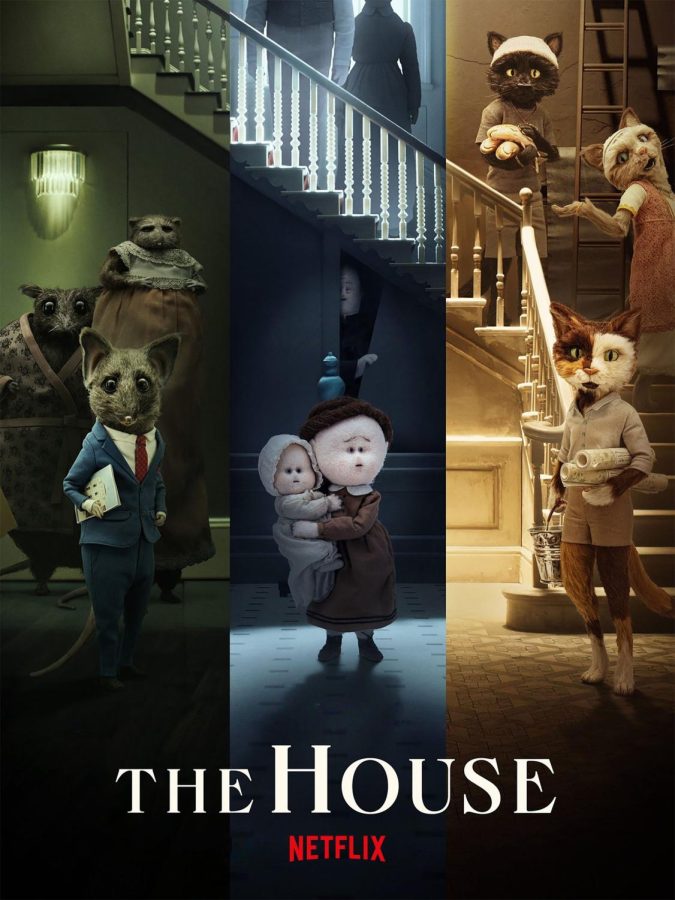Netflix’s anthology series, The House, presents the issues with materialism in a stylistic light
Depicted are the three separate short films that make up the film: the first (middle), the second (left), and the last (right).
Wooly and felt faces, eerily small features, and enlarged heads glared at me in pixels from the corner of my TV screen.
As plain as a movie titled The House may sound, this Netflix Original film was anything but ordinary. Thought-provoking and unsettling stop-motion animation and plotlines leave the viewer in a fading state of uncomfortable, yet necessary, self-reflection. The movie consists of three separate short films, all shot by different directors and running for about thirty minutes apiece, sandwiched together in a past, present, and future sequence.
The first story is the origin of the house, and arguably the most impactful and captivating out of the three. Alongside that, it is also the most disturbing out of the three, with especially unsettling facial expressions and features that highlight the characters’ intrigue. The film wastes no time by quickly describing the family dynamic, with emphasis on the father who has a complex relationship with the wealthier side of the extended family, more of a power struggle if you will.
The family is offered an opportunity to leave behind all of their old material possessions in exchange for a lavish upgrade to a new house with furniture, food, and other amenities all included. The father quickly grabs hold of the offer from the mysterious architect to prove a higher status after being demeaned by relatives. This marks the beginning of the downfall of both the father and the mother, and the dark and twisted turn the house and animation take here-on.
Upon arrival, the mother and father become obsessed with the expensive items found in their new house, tossing aside their two daughters and running off to explore like little kids on a playground. Immediately, the oldest daughter is suspicious about the house and tucks her younger sister and herself to bed while the parents are fixated on the light fixtures in the dining room.
Later on, the mother and father receive clothing pieces from the architect of the house that resemble the furnishings as their deep emerald color with gold trim defines the outfits. The oldest daughter gets upset after watching her parents stare, mesmerized by themselves in the mirror for an extended period of time, and goes off to find her younger sister. Later that night, they decide to spend some time exploring the house and discover their old belongings tucked away in a dusty basement, only then to discover their father the very next day dragging the wooden furniture towards the fireplace that had encapsulated him from their very arrival. He can be seen chuckling to himself in a cynical, almost senile manner—as if he had aged in some distasteful way.
The first chapter ends with a direct social dig towards materialism in our world today, showing the mother and father transformed into the very furniture that lay in the living room of the house. The eldest daughter’s dollhouse is seen burning, and starts to ignite the mother and father as she and her sister are the only ones who did not lose themselves to the lifestyle this house demonstrated.
The second short film starts off much less intimidating than the first. From the lighting to the character design, it seems the house has had a significant makeover since the earlier time period we last saw it. Nonetheless, it still stands, ready for a furry felt mouse who doubles as a mentally ill contractor to redo the residence in order to turn it over for profit.
From the opening shot, we can see debt notices tacked up on the walls and the haste of a success-hungry individual in the voice of this contractor. Already, the main social-issue focus of this chapter is the greed coming out of a desire for extravagant and unnecessary things.
Throughout the film, the contractor is depicted searching high and low, practically breaking himself just to install some of the finest, yet ridiculous, amenities to the house before a showing. When the date arrives for the open house, many people walk away from the sale after seeing the unnecessary nature of the decor, yet an eerie, oddball couple shows interest.
Curiously enough, they wind up being squatters in the house for almost two days, but, at this point, the contractor finally loses it when he realizes that he will not be closing a deal on this house as his debt continues to pile to astronomical heights during the recession. He ends up throwing bug toxin at them, or attempting to, and winds up unconscious in the hospital until the couple comes, later on, to collect him as he, almost in a trance, eerily follows them out and back to the home where he is welcomed by a significant group of vermin. The final scene shows all of the individuals then transformed into various types of looking bugs and pests, and are seen violently ripping away at the house and tearing into the nice furnishings and expensive appliances before cutting to black.
The final chapter, unfortunately, falls short in comparison to the other two films in the anthology, but nonetheless represents the feeling of being tied down conditionally by money. It follows a struggling cat who has struggled to create an apartment building out of the house she has had her eye on for as long as she can remember. In this futuristic depiction, the entirety of the area is flooded except for the house, since it is perched on the very top of the hill, and she only has two tenants who never pay their rent in cash but instead with crystals and fish.
She grows angry with the two other cats residing in the house, especially because she isn’t making enough money to remodel the place she has idolized for so long. And, as the film comes to a close, the flood begins to rise as the house breaks away from the land—seeming to mark the end of the continuous cycle of behavior in the residence.
Although the movie as a whole would have been a lot stronger if the final film would have carried a bit more of that eerie weight that the other two did, especially the first, all make very strong social arguments about the impacts of money on all levels and functions of society.

Kelsey Dantuma is a senior entering her third and final year on staff for The Central Trend. In all honesty, Kelsey has found a home through writing for...



























































































